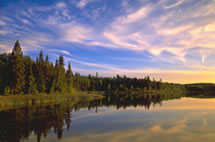Threats to forest water resources
Forest disturbances
When forests are disturbed on a small scale (less than 10 square kilometres), the effects on water are relatively well known. Full or partial removal of a small forest—whether through natural disturbances (such as fire or insect infestation) or through harvesting—causes an immediate drop in evapotranspiration. The result: more moisture in the soil and more runoff.

As the forest regrows, however, evapotranspiration increases, with soil moisture and runoff usually returning to pre-disturbance levels in three to five years. Over the longer term, the rapidly growing forest may experience a greater rate of evapotranspiration, thus reducing soil moisture and runoff.
Small forest disturbances also change the way elements cycle through forest soils. In the short term, disturbances can lead to greater export of some elements (such as nitrogen and phosphorous) to surface waters, which can affect aquatic ecosystems.
What is not as well known is how many small disturbances cumulatively might affect water quality and quantity in large river systems. It is also not clear what the consequences might be for aquatic biodiversity and productivity.
Climate change
A warming planet could change the water cycle significantly. The most likely effects include:
- changes in the frequency and intensity of precipitation, changes in the distribution of precipitation events throughout the year, less snow accumulation and earlier spring melts
- increased frequency and duration of drought
- increased evaporation because of higher temperatures.
An altered water cycle could in turn lead to changes in species distribution; more damage as a result of extreme weather (such as ice storms, floods, blow-downs and droughts); and more stress on forests that are already coping with insects, diseases and air pollution. Climate change might also modify the physical, chemical and biological processes of soil.
Together, these changes could have a big impact on the quality and quantity of water from forested areas.
Air pollution
Burning fossil fuels and smelting ore are two activities that release many pollutants into the atmosphere. The polluting substances, such as fossil fuel and smelting ore, can become concentrated in plants and animals, threatening their health. Air pollution can also cause acid precipitation. Acid precipitation is formed when oxides of nitrogen and sulphur combine with water in the atmosphere and fall as rain, snow, sleet or other precipitate. Acid precipitation affects aquatic ecosystems directly when it falls on lakes and streams. It also affects forests.
While some forests and forest soils are able to neutralize the acids and prevent their damage, large areas of eastern Canada cannot do this. Acid rain depletes the essential nutrients in forest soils and mobilizes the toxic metals, such as aluminum. High acidity and toxic metals then pose a risk to the health of terrestrial and aquatic ecosystems.
Page details
- Date modified: